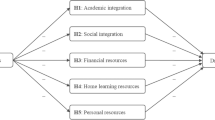Abstract
A causal model of student attrition developed by the author (Bean, 1981) was reduced to 10 independent variables. Background variables were excluded from the analysis. The sample was partitioned into high- and low-confidence men and women based on interaction effects. The model was estimated using a sample of 1,574 college freshmen. TheR 2 for dropout ranged from .42 to .50. Based on the effects coefficients, the overall ranking of the independent variables in influencing dropout in descending order of importance was as follows: intent to leave; grades; opportunity to transfer; practical value; certainty of choice; loyalty; family approval; courses; student goals; and major and job certainty.
Similar content being viewed by others
References
Ajzen, I., and Fishbein, M.Understanding Attitudes and Predicting Social Behavior. Englewood Cliffs, New Jersey: Prentice-Hall, 1980.
Bean, J. P.Student attrition, intentions, and confidence: Interaction effects in a path model. Part I. The twenty-three variable model. Paper presented at the annual meeting of the American Education Research Association, Los Angeles, April 1981. (ERIC Document Reproduction Service # HE 013 983.)
--. The application of a model of turnover in work organizations to the student attrition process.Review of Higher Education (forthcoming).
Durkheim, E.Suicide. Translated by J. Spaulding and G. Simpson. Glencoe: The Free Press, 1961.
Fishbein, M., and Ajzen, I.Belief, Attitude, Intention and Behavior: An Introduction to Theory and Research. Reading, Mass.: Addison-Wesley, 1975.
Griffin, N. S., and Koegh, J. F. A model for movement confidence. In J. A. S. Kelso and J. E. Clark (eds.),The Development of Movement Control and Coordination. New York: John Wiley and Sons, Ltd. (in press).
Land, K. C. Principles of path analysis. In E. F. Borgatta (ed.),Sociological Methodology. San Francisco: Jossey-Bass, 1969.
Lewis-Beck, M. S. The relative importance of socioeconomic and political variables for public policy.American Political Science Review 1977,71 559–566.
Lewis-Beck, M. S., and Mohr, L. B. Evaluating effects of independent variables.Political Methodology 1976,3 27–47.
Kerlinger, F. L.Foundations of Behavioral Research (2nd ed.). New York: Holt, Rinehart and Winston, 1973.
Kerlinger, F. L., and Pedhazur, E. J.Multiple Regression in Behavioral Research. New York: Holt, Rinehart and Winston, 1973.
Kim, J., and Mueller, C. W.,Factor Analysis: Statistical Methods and Practical Issues. Sage University Paper Series on Quantitative Applications in the Social Sciences (Series No. 07-014). Beverly Hills and London: Sage Publications, 1978.
Pascarella, E. T., and Terenzini, P. T. Interaction effects in Spady's and Tinto's conceptual models of college dropout.Sociology of Education 1979,52 197–210.
Pascarella, E. T. Student-faculty informal contact and college outcomes.Review of Educational Research 1980,50 545–595.
Spady, W. Dropouts from higher education: An interdisciplinary review and synthesis.Interchange 1970,1 64–85.
Tinto, V. Dropout from higher education: A theoretical synthesis of recent research.Review of Educational Research 1975,45 89–125.
Walberg, H. J., and Rasher, S. P. Improving regression models.Journal of Educational Statistics 1976,1 253–277.
Author information
Authors and Affiliations
Rights and permissions
About this article
Cite this article
Bean, J.P. Student attrition, intentions, and confidence: Interaction effects in a path model. Res High Educ 17, 291–320 (1982). https://doi.org/10.1007/BF00977899
Received:
Issue Date:
DOI: https://doi.org/10.1007/BF00977899



